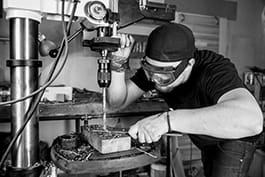Profession drilling machine operator

Boring machine operators operate machinery and equipment at mining and drilling sites, e.g. for construction, exploration, extraction and research.
Would you like to know what kind of career and professions suit you best? Take our free Holland code career test and find out.
Personality Type
Tasks drilling machine operator
- Move drilling equipment to the right location, e.g. by driving or controlling its load and upload.
- Set up drilling and hoisting machinery, e.g. by connecting drill pipe sections, etc.
- Connect power cables or hoses for water and air supply.
- Operate the drilling machinery, e.g. by regulating pressure of tools, controlling the speed of rotary tables and air flow, etc.
- Operate slush pumps in order to ensure circulation and consistency of drilling fluid or mud in well.
- Correct problems in drilled holes caused by mechanical breakdowns or by harmful natural conditions.
- Locate and recover lost or broken bits, casings, drill pipes, etc. from wells using special tools.
- Maintain records, e.g. of footage drilled, materials and tools used, etc.
- Report information about the drilling process to the supervisor.
- Supervise and train crew.
Related professions oil, gas
- Boat or derrick operator
- First line supervisor oil or gas workers
- Gas compressor or gas pumping station operator
- Mains pipes layer-jointer
- Oil or gas geologist
- Oil or gas well driller
- Oiler, greaser
- Operator service unit oil or gas well
- Petroleum chemist
- Petroleum or natural gas refining plant operator
- Pipe fitter
- Pipeline worker
- Roustabout oil or gas
- Well digger
- Well driller (not in gas and oil)
- Well service unit operator (not in gas and oil)
- Well sinker
Knowledge
- CADD software
The computer-aided design and drafting (CADD) is the use of computer technology for design and design documentation. CAD software replaces manual drafting with an automated process.
- Quality and cycle time optimisation
The most optimal rotation or cycle time and over-all quality of a tool or a machine's processes.
- CAM software
Different tools for computer-aided manufacturing (CAM) to control machinery and machine tools in the creation, modification, analysis, or optimisation as part of the manufacturing processes of workpieces.
- Statistical process control
Method of quality control that uses statistics to monitor processes.
- CAD software
The computer-aided design (CAD) software for creating, modifying, analysing or optimising a design.
- Quality standards
The national and international requirements, specifications and guidelines to ensure that products, services and processes are of good quality and fit for purpose.
- CAE software
The software to perform computer-aided engineering (CAE) analysis tasks such as Finite Element Analysis and Computional Fluid Dynamics.
Skills
- Read standard blueprints
Read and comprehend standard blueprints, machine, and process drawings.
- Operate drilling equipment
Operate a range of drilling equipment, pneumatic as well as electrical and mechanical. Tend drilling equipment, monitor and operate it, according to regulations. Safely and efficiently drill holes using the correct equipment, settings, and drill bits.
- Operate precision measuring equipment
Measure the size of a processed part when checking and marking it to check if it is up to standard by use of two and three dimensional precision measuring equipment such as a caliper, a micrometer, and a measuring gauge.
- Troubleshoot
Identify operating problems, decide what to do about it and report accordingly.
- Remove inadequate workpieces
Evaluate which deficient processed workpieces do not meet the set-up standard and should be removed and sort the waste according to regulations.
- Dispose of cutting waste material
Dispose of possibly hazardous waste material created in the cutting process, such as swarf, scrap and slugs, sort according to regulations, and clean up workplace.
- Consult technical resources
Read and interpret such technical resources such as digital or paper drawings and adjustment data in order to properly set up a machine or working tool, or to assemble mechanical equipment.
- Perform test run
Perform tests putting a system, machine, tool or other equipment through a series of actions under actual operating conditions in order to assess its reliability and suitability to realise its tasks, and adjust settings accordingly.
- Use CAM software
Use computer-aided manufacturing (CAM) programmes to control machinery and machine tools in the creation, modification, analysis, or optimisation as part of the manufacturing processes of workpieces.
- Interpret geometric dimensions and tolerances
Understand and assess the models and symbolic language of the GD&T system indicating engineering tolerances.
- Supply machine
Ensure the machine is fed the necessary and adequate materials and control the placement or automatic feed and retrieval of work pieces in the machines or machine tools on the production line.
- Ensure equipment availability
Ensure that the necessary equipment is provided, ready and available for use before start of procedures.
- Monitor automated machines
Continuously check up on the automated machine's set-up and execution or make regular control rounds. If necessary, record and interpret data on the operating conditions of installations and equipment in order to identify abnormalities.
Optional knowledge and skills
manufacturing of light metal packaging geometry ferrous metal processing inspect quality of products electrical engineering trigonometry mechanics program a cnc controller monitor stock level manufacturing of steam generators types of metal manufacturing processes supply machine with appropriate tools keep records of work progress provide advice to technicians procure mechanical machinery manufacturing of heating equipment manufacturing of sports equipment record production data for quality control work ergonomically manufacturing of steel drums and similar containers mark processed workpiece manufacturing of tools manufacturing of daily use goods manufacturing of doors from metal liaise with managers manufacturing of metal containers maintain mechanical equipment manufacturing of metal structures types of metal cutting technologies tend cnc drilling machine manufacturing of metal assembly products manufacturing of weapons and ammunitionSource: Sisyphus ODB